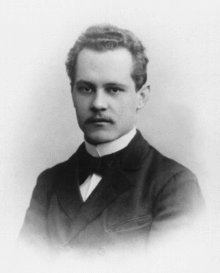Sommerfeld
Arnold Johannes Wilhelm Sommerfeld, ForMemRS (German: [ˈzɔmɐˌfɛlt]; 5 December 1868 – 26 April 1951) was a German theoretical physicist who pioneered developments in atomic and quantum physics, and also educated and mentored a large number of students for the new era of theoretical physics. He served as PhD supervisor for many Nobel Prize winners in physics and chemistry (only J. J. Thomson's record of mentorship is comparable to his).
He introduced the 2nd quantum number (azimuthal quantum number) and the 4th quantum number (spin quantum number). He also introduced the fine-structure constant and pioneered X-ray wave theory.
Sommerfeld studied mathematics and physical sciences at the Albertina University of his native city, Königsberg, East Prussia. His dissertation advisor was the mathematician Ferdinand von Lindemann, and he also benefited from classes with mathematicians Adolf Hurwitz and David Hilbert and physicist Emil Wiechert. His participation in the student fraternity Deutsche Burschenschaft resulted in a fencing scar on his face. He received his Ph.D. on October 24, 1891 (age 22).
After receiving his doctorate, Sommerfeld remained at Königsberg to work on his teaching diploma. He passed the national exam in 1892 and then began a year of military service, which was done with the reserve regiment in Königsberg. He completed his obligatory military service in September 1893, and for the next eight years continued voluntary eight-week military service. With his turned up moustache, his physical build, his Prussian bearing, and the fencing scar on his face, he gave the impression of being a colonel in the hussars.
...
Wikipedia

